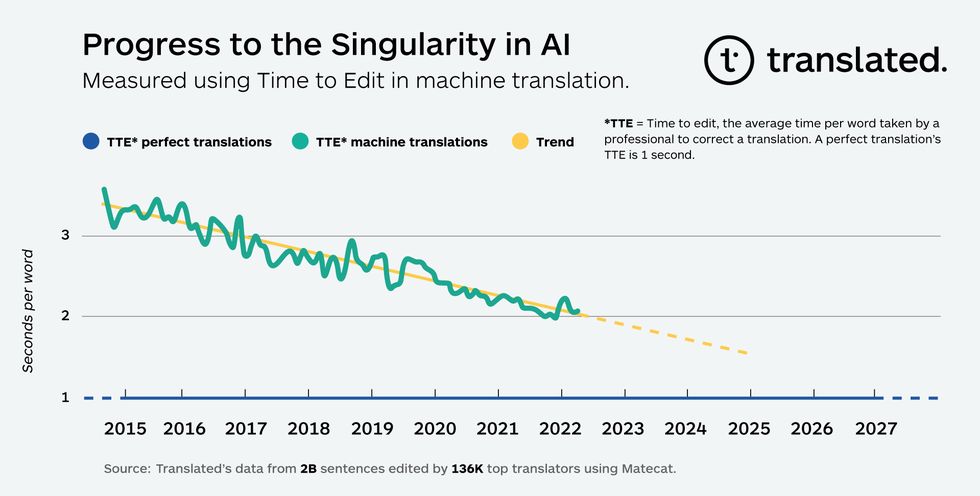- By one unique metric, we could approach technological singularity by the end of this decade, if not sooner.
- A translation company developed a metric, Time to Edit (TTE), to calculate the time it takes for professional human editors to fix AI-generated translations compared to human ones. This may help quantify the speed toward singularity.
- An AI that can translate speech as well as a human could change society.
In the world of artificial intelligence, the idea of “singularity” looms large. This slippery concept describes the moment AI exceeds beyond human control and rapidly transforms society. The tricky thing about AI singularity (and why it borrows terminology from black hole physics) is that it’s enormously difficult to predict where it begins and nearly impossible to know what’s beyond this technological “event horizon.”
However, some AI researchers are on the hunt for signs of reaching singularity measured by AI progress approaching the skills and ability comparable to a human. One such metric, defined by Translated, a Rome-based translation company, is an AI’s ability to translate speech at the accuracy of a human. Language is one of the most difficult AI challenges, but a computer that could close that gap could theoretically show signs of Artificial General Intelligence (AGI).
“That’s because language is the most natural thing for humans,” Translated CEO Marco Trombetti said at a conference in Orlando, Florida, in December. “Nonetheless, the data Translated collected clearly shows that machines are not that far from closing the gap.”
The company tracked its AI’s performance from 2014 to 2022 using a metric called “Time to Edit,” or TTE, which calculates the time it takes for professional human editors to fix AI-generated translations compared to human ones. Over that 8-year period and analyzing over 2 billion post-edits, Translated’s AI showed a slow, but undeniable improvement as it slowly closed the gap toward human-level translation quality.
On average, it takes a human translator roughly one second to edit each word of another human translator, according to Translated. In 2015, it took professional editors approximately 3.5 seconds per word to check a machine-translated (MT) suggestion — today that number is just 2 seconds. If the trend continues, Translated’s AI will be as good as human-produced translation by the end of the decade (or even sooner).
“The change is so small that every single day you don’t perceive it, but when you see progress … across 10 years, that is impressive,” Trombetti said on a podcast in December. “This is the first time ever that someone in the field of artificial intelligence did a prediction of the speed to singularity.”
Although this is a novel approach to quantifying how close humanity is to approaching singularity, this definition of singularity runs into similar problems of identifying AGI more broadly. Although perfecting human speech is certainly a frontier in AI research, the impressive skill doesn’t necessarily make a machine intelligent (not to mention how many researchers don’t even agree on what “intelligence” is).
Whether these hyper-accurate translators are harbingers of our technological doom or not, that doesn’t lessen Translated’s AI accomplishment. An AI capable of translating speech as well as a human could very well change society, even if the true “technological singularity” remains ever elusive.
News
Fever-Proof Bird Flu Variant Could Fuel the Next Pandemic
Bird flu viruses present a significant risk to humans because they can continue replicating at temperatures higher than a typical fever. Fever is one of the body’s main tools for slowing or stopping viral [...]
What could the future of nanoscience look like?
Society has a lot to thank for nanoscience. From improved health monitoring to reducing the size of electronics, scientists’ ability to delve deeper and better understand chemistry at the nanoscale has opened up numerous [...]
Scientists Melt Cancer’s Hidden “Power Hubs” and Stop Tumor Growth
Researchers discovered that in a rare kidney cancer, RNA builds droplet-like hubs that act as growth control centers inside tumor cells. By engineering a molecular switch to dissolve these hubs, they were able to halt cancer [...]
Platelet-inspired nanoparticles could improve treatment of inflammatory diseases
Scientists have developed platelet-inspired nanoparticles that deliver anti-inflammatory drugs directly to brain-computer interface implants, doubling their effectiveness. Scientists have found a way to improve the performance of brain-computer interface (BCI) electrodes by delivering anti-inflammatory drugs directly [...]
After 150 years, a new chapter in cancer therapy is finally beginning
For decades, researchers have been looking for ways to destroy cancer cells in a targeted manner without further weakening the body. But for many patients whose immune system is severely impaired by chemotherapy or radiation, [...]
Older chemical libraries show promise for fighting resistant strains of COVID-19 virus
SARS‑CoV‑2, the virus that causes COVID-19, continues to mutate, with some newer strains becoming less responsive to current antiviral treatments like Paxlovid. Now, University of California San Diego scientists and an international team of [...]
Lower doses of immunotherapy for skin cancer give better results, study suggests
According to a new study, lower doses of approved immunotherapy for malignant melanoma can give better results against tumors, while reducing side effects. This is reported by researchers at Karolinska Institutet in the Journal of the National [...]
Researchers highlight five pathways through which microplastics can harm the brain
Microplastics could be fueling neurodegenerative diseases like Alzheimer's and Parkinson's, with a new study highlighting five ways microplastics can trigger inflammation and damage in the brain. More than 57 million people live with dementia, [...]
Tiny Metal Nanodots Obliterate Cancer Cells While Largely Sparing Healthy Tissue
Scientists have developed tiny metal-oxide particles that push cancer cells past their stress limits while sparing healthy tissue. An international team led by RMIT University has developed tiny particles called nanodots, crafted from a metallic compound, [...]
Gold Nanoclusters Could Supercharge Quantum Computers
Researchers found that gold “super atoms” can behave like the atoms in top-tier quantum systems—only far easier to scale. These tiny clusters can be customized at the molecular level, offering a powerful, tunable foundation [...]
A single shot of HPV vaccine may be enough to fight cervical cancer, study finds
WASHINGTON -- A single HPV vaccination appears just as effective as two doses at preventing the viral infection that causes cervical cancer, researchers reported Wednesday. HPV, or human papillomavirus, is very common and spread [...]
New technique overcomes technological barrier in 3D brain imaging
Scientists at the Swiss Light Source SLS have succeeded in mapping a piece of brain tissue in 3D at unprecedented resolution using X-rays, non-destructively. The breakthrough overcomes a long-standing technological barrier that had limited [...]
Scientists Uncover Hidden Blood Pattern in Long COVID
Researchers found persistent microclot and NET structures in Long COVID blood that may explain long-lasting symptoms. Researchers examining Long COVID have identified a structural connection between circulating microclots and neutrophil extracellular traps (NETs). The [...]
This Cellular Trick Helps Cancer Spread, but Could Also Stop It
Groups of normal cbiells can sense far into their surroundings, helping explain cancer cell migration. Understanding this ability could lead to new ways to limit tumor spread. The tale of the princess and the [...]
New mRNA therapy targets drug-resistant pneumonia
Bacteria that multiply on surfaces are a major headache in health care when they gain a foothold on, for example, implants or in catheters. Researchers at Chalmers University of Technology in Sweden have found [...]
Current Heart Health Guidelines Are Failing To Catch a Deadly Genetic Killer
New research reveals that standard screening misses most people with a common inherited cholesterol disorder. A Mayo Clinic study reports that current genetic screening guidelines overlook most people who have familial hypercholesterolemia, an inherited disorder that [...]






















